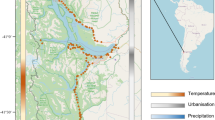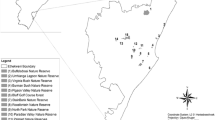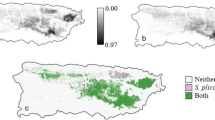Abstract
Today’s urban green space is exposed to a constant flow of newly introduced exotic plant species, resulting from multiple, intentional and inadvertent introductions. A substantial share of introduced plant species are represented by potential invaders of plant communities, which allows considering that the risk of rapid dispersion by aggressive plant species to be today’s most serious threat to the urban biodiversity. Alien plant species with a short life span (monocarps, therophytes, annuals and biennials) are the most successful invaders across anthropogenically transformed landscapes. These species can have a significant impact on the functioning of previously disturbed ecosystems. At the same time, it is still unclear which mechanisms enable short-lived monocarps to invade under specific conditions of urban forest interiors. Therefore, I have conducted a literature analysis aiming at identifying possible biological and ecological determinants of monocarpic plants’ invasive success in urban woodlands. The analysis was made at three qualitative levels taking into account characteristics of the urban environment, those of different types of urban woodlands as well as traits of non-native monocarpic species. Considering the city level, the main ecological factors are the high level of human-induced disturbance and propagule pressure on the urban-woodland interface sites. The level of invasion as well as invasibility of urban woodlands is mainly determined by the landscape context, whereas the habitat type, species composition and spatial structure play a less important role. In the forest environment, where competition for light and nutrients is the main shaping factor of the phytocoenosis, short-lived alien species must possess a certain level of competitive ability. These findings indicate that this ability may be due to such traits as high fecundity rates, effective dispersal mechanisms, early germination, high rate of growth and the overall big size of plants, presence of autonomous pollination and high shade-tolerance.
Similar content being viewed by others
References
Alberti M (2005) The effects of urban patterns on ecosystem function. Int Reg Sci Rev 28(2):168–192
Alpert P, Bone E, Holzapfel C (2000) Invasiveness, invasibility and the role of environmental stress in the spread of non-native plants. Perspect Plant Ecol Evol Syst 3(1):52–66
Alvey AA (2006) Promoting and preserving biodiversity in the urban forest. Urban For Urban Green 5:195–201
Barrett SCH (2011) Why reproductive systems matter for the invasion biology of plants. In: Richardson DM (ed) Fifty years of invasion ecology: The legacy of Charles Elton. Oxford University Press, Oxford, pp 195–210
Bauer JT (2012) Invasive species: “Back-seat drivers” of ecosystem change? Biol Inv 14:1295–1304
Berezutsky MA (1999) Anthropogenic transformation of flora. Bot J 84(6):8–19 (In Russian)
Bertin RI (2002) Losses of native plant species from Worcester, Massachusetts. Rhodora 104:325–349
Bolker BM, Pacala SW (1999) Spatial moment equations for plant competition: understanding spatial strategies and the advantage of short dispersal. Am Nat 153:575–602
Bonser SP, Ladd B (2011) The evolution of competitive strategies in annual plants. Plant Ecol 212(9):1441–1449
Booth BD, Murphy SD, Swanton CJ (2003) Weed ecology in natural and agricultural systems. CABI Publishing, Wallingford
Borgmann KL, Rodewald AD (2005) Forest restoration in urbanizing landscapes: interactions between land-uses and exotic shrubs. Restor Ecol 13:334–340
Brothers ST, Spingarn A (1992) Forest fragmentation and alien plant invasion of Central Indiana old-growth forests. Conserv Biol 6:91–100
Cadenasso ML, Pickett STA (2000) Effect of edge structure on the flux of species into forest interiors. Conserv Biol 15(1):91–97
Charbonneau NC, Fahrig L (2004) Influence of canopy cover and amount of open habitat in the surrounding landscape on proportion of alien plant species in forest sites. Ecoscience 11(3):278–281
Chmura D, Sierka E (2006) Relation between invasive plant and species richness of forest floor vegetation: a study of Impatiens parviflora DC. Pol J Ecol 54(3):417–428
Clauss MJ, Venable DL (2000) Seed germination in desert annuals: an empirical test of adaptive bet hedging. Am Nat 155:168–186
Crawley MJ, May RM (1987) Population dynamics and plant community structure: competition between annuals and perennials. J Theor Biol 125:475–489
D’Antonio CM, Dudley TL, Mack M (1999) Disturbance and biological invasions: Direct effects and feedbacks. In: Walker LR (ed) Ecosystems of disturbed ground. Elsevier, Amsterdam, pp 413–452
Daehler CC (2003) Performance comparisons of co-occurring native and alien plants: implications for conservation and restoration. Annu Rev Ecol Syst 34:183–211
Davis MA, Grime JP, Thomson K (2000) Fluctuating resources in plant communities: a general theory of invasibility. J Ecol 88:528–534
Del Tredici P (2010) Spontaneous urban vegetation: reflections of change in a globalized world. Nat Cult 5(3):299–315
Dlugosch KM, Parker IM (2008) Founding events in species invasions: genetic variation, adaptive evolution, and the role of multiple introductions. Mol Ecol 17:431–449
Dobravolskaitė R, Gudžinskas Z (2011) Alien plant invasion to forests in the vicinity of communal gardens. Bot Lithuanica 17(2–3):73–84
Donoghue MJ (2008) A phylogenetic perspective on the distribution of plant diversity. Proc Nat Acad Sci USA 105:11549–11555
Duguay S, Eigenbrod F, Fahrig E (2007) Effects of surrounding urbanization on non-native flora in small forest patches. Land Ecol 22:589–599
Eckert CG, Kalisz S, Geber MA, Sargent RD, Elle E (2010) Plant mating systems in a changing world. Trends Ecol Evol 25:35–43
Essl F, Milasowszky N, Dirnbock T (2011) Plant invasions in temperate forests: resistance or ephemeral phenomenon? Basic Appl Ecol 12:1–9
Essl F, Mang T, Moser D (2012) Ancient and recent alien species in temperate forests: steady state and time lags. Biol Inv 14:1331–1342
Evans AS, Cabin RJ (1995) Can dormancy affect the evolution of post-germination traits – The case of Lesquerella fendleri. Ecology 76:344–356
Fenesi A, Botta-Dukat Z (2010) Do short-lived and long-lived plant species differ regarding the traits associated with their invasiveness? Biol Inv 12:611–623
Gilbert OL (1989) The ecology of urban habitats. Chapman & Hall, London
Godefroid S, Koedam N (2003) Identifying indicator plant species of habitat quality and invasibility as a guide for peri-urban forest management. Biodivers Conserv 12:1699–1713
Godoy O, Saldana A, Fuentes N (2011) Forests are not immune to plant invasions: phenotypic plasticity and local adaptation allow Prunella vulgaris to colonize a temperate evergreen rainforest. Biol Inv 13:1615–1625
Guo Q, Thompson DB, Valone TJ, Brown JH (1995) The effect of vertebrate granivores and folivores on plant community structure in the Chihuahuan Desert. Oikos 73:251–259
Hierro JL, Villarreal D, Eren O, Graham JM, Callaway RM (2006) Disturbance facilitates invasion: the effects are stronger abroad than at home. Am Nat 168(2):144–156
Hobbs RJ, Huenneke LF (1992) Disturbance, diversity and invasion: implications for conservation. Conserv Biol 6(3):324–337
Honnay O, Endels P, Vereecken H, Hermy M (1999) The role of patch area and habitat diversity in explaining native plant species richness in disturbed suburban forest patches in northern Belgium. Divers Distrib 5:129–141
Honnay O, Verheyen K, Hermy M (2002) Permeability of ancient forest edges for weedy plant species invasion. For Ecol Manag 161:109–122
James JJ (2008) Leaf nitrogen productivity as a mechanism driving the success of invasive annual grasses under low and high nitrogen supply. J Arid Env 72:1775–1784
Jarošík V, Pyšek P, Kadlec T (2011) Alien plants in urban nature reserves: from red-list species to future invaders? NeoBiota 10:27–46
Klotz S (1990) Species/area and species/inhabitants relations in European cities. In: Sukopp H, Hejny S, Kowarik I (eds) Urban ecology: Plants and plant communities in urban environments. SPB Academic Publ, The Hague, pp 99–104
Kornaš J (1971) Modern anthropogenic changes in the flora of Poland. Ukr Bot J 28(2):167–173, In Ukrainian
Kowarik I (1995) On the role of alien species in urban flora and vegetation. In: Pyšek P, Prach K, Rejmanek M, Wade PM (eds) Plant invasions – general aspects and special problems. SPB Academic, Amsterdam, pp 85–103
Kowarik I (2003) Human agency in biological invasions: secondary releases foster naturalization and population expansion of alien plant species. Biol Inv 5:293–312
Kowarik I, Körner S (2005) Wild urban woodlands: New perspectives for urban forestry. Springer, Berlin
Kuhn I, May R, Brandl R, Klotz S (2003) Plant distribution patterns in Germany: will aliens match natives? Feddes Repertorium 114:559–573
Kuhn I, Brandl R, Klotz S (2004) The flora of German cities is naturally species rich. Evol Ecol Res 6:749–764
Levin DA (1990) The seed bank as a source of genetic novelty in plants. Am Nat 135:563–572
Lonsdale WM (1999) Global patterns of plant invasions and the concept of invisibility. Ecol 80:1522–1536
Lososova Z, Chytry M, Kuhn I, Hájek O, Horáková V, Pyšek P, Tichý L (2006) Patterns of plant traits in annual vegetation of man-made habitats in central Europe. Perspect Plant Ecol Evol Syst 8:69–81
Lysik M (2008) Ten years of change in ground-layer vegetation of European beech forest in the protected area (Ojcow National Park, South Poland). Pol J Ecol 56(1):17–31
Mack RN, Lonsdale WM (2001) Humans as global plant dispersers: getting more than we bargained for. BioScience 51:95–102
Markov MV (1987) Population biology of short-lived monocarpic plants. Biol Sci 8:39–46 (In Russian)
Markov MV (1989) Algorithm of population-botanical analysis of short-lived plants: architecture model – life-form – ecological-coenotic strategy. Biol Sci 11:90–104 (In Russian)
Martin PH, Canham CD, Marks PL (2009) Why forests appear resistant to exotic plant invasions: intentional introductions, stand dynamics, and the role of shade tolerance. Front Ecol Env 7(3):142–149
Matus G, Verhagen R, Bekker RM (2001) Soil seed bank and vegetation composition of two fenmeadow stands in the Netherlands. Acta Bot Hung 43:349–366
McCue KA, Holtsford TP (1998) Seed bank influences on genetic diversity in the rare annual Clarkia springvillensis (Onagraceae). Am J Bot 85(1):30–36
McDonnell M, Pickett S, Groffman P et al (1997) Ecosystem processes along an urban-to-rural gradient. Urb Ecos 1:21–36
McKinney ML (2004) Measuring floristic gomogenization by non-native plants in North America. Glob Ecol Biogr 13:47–53
McKinney ML (2006) Urbanization as a major cause of biotic homogenization. Biol Conserv 127:247–260
Mirkin BM, Naumova LG (2002) The vegetation adventization through perspective of current ecological ideas. J Gen Biol 63(6):500–508
Moore MR, Vankat JL (1986) Responses of the herb layer to the gap dynamics of a mature beech-maple forest. Am Mid Nat 115(2):336–347
Moravcová L, Pyšek P, Jarošík V et al (2010) Reproductive characteristics of neophytes in the Czech Republic: traits of invasive and non-invasive species. Preslia 82:365–390
Noble IR (1989) Attributes of invaders and the invading process: Terrestrial and vascular plants. In: Drake JA, Mooney HA, di Castri F, Groves RH, Kruger FJ, Rejmanek M, Williamson M (eds) Biological invasions: A global perspective. Wiley & Sons, New York, pp 301–313
Ohlemuller R, Walker S, Wilson JB (2006) Local vs. regional factors as determinants of the invasibility of indigenous forest fragments by alien plant species. Oikos 112:493–501
Ohta T (1973) Population size and rate of evolution. J Mol Evol 1(4):305–314
Pyšek P (1998) Alien and native species in Central European urban floras: a quantitative comparison. J Biogr 25:155–163
Pyšek P, Richardson DM (2007) Traits associated with invasiveness in alien plants: Where do we stand? In: Nentwig W (ed) Biological invasions, ecological studies 193. SpringerVerlag, Berlin & Heidelberg, pp 97–126
Pyšek P, Prach K, Šmilauer P (1995) Relating invasion success to plant traits: an analysis of Czech alien flora. In: Pyšek P, Prach K, Rejmanek M, Wade M (eds) Plant invasions – general aspects and special problems. Academic Publishing, Amsterdam, pp 39–60
Pyšek P, Jarošık V, Kucera T (2002) Patterns of invasion in temperate nature reserves. Biol Conserv 104:13–24
Pyšek P, Sádlo J, Mandak B (2003) Alien flora of the Czech Republic, its composition, structure and history. In: Child LE, Brock JH, Brundu G, Prach K, Pyšek P, Wade PM, Williamson M (eds) Plant invasions: Ecological threats and management solutions. Backhuys Publishers, Leiden, pp 113–130
Pyšek P, Jarošík V, Pergl J et al (2009) The global invasion success of Central European plants is related to distribution characteristics in their native range and species traits. Divers Distrib 15:891–903
Rapoport EH (2000) Remarks on the biogeography of land invasions. Rev Chil Hist Nat 73:367–380
Rees M (1993) Trade-offs among dispersal strategies in British plants. Nature 366:150–152
Rees M, Condit R, Crawley M, Pacala S, Timan D (2001) Long-term studies of vegetation dynamics. Science 293:650–655
Rejmanek M (1996) A theory of seed plant invasiveness: the first sketch. Biol Conserv 78:171–181
Rejmanek M, Richardson DM (1996) What attributes make some plant species more invasive? Ecol 77:1655–1661
Richardson DM, Pysek P (2006) Plant invasions: merging the concepts of species invasiveness and community invisibility. Prog Phys Geogr 30(3):409–431
Ricotta C, Godefroid S, Rocchini D (2009) Patterns of native and exotic species richness in the urban flora of Brussels: rejecting the ‘rich get richer’ model. Biol Inv 12:233–240
Ricotta C, Godefroid S, Rocchini D (2010) Invasiveness of alien plants in Brussels is related to their phylogenetic similarity to native species. Divers Distrib 16:655–662
Ross KA, Fox BJ, Fox MD (2002) Changes to plant species richness in forest fragments: fragment age, disturbance and fire history may be as important as area. J Biogeogr 29:749–765
Shea K, Chesson P (2002) Community ecology theory as a framework for biological invasions. Trends Ecol Evol 17(4):170–176
Stapanian MA, Sundberg SD, Baumgardner GA, Liston A (1998) Alien plant species composition and associations with anthropogenic disturbance in North American forests. Plant Ecol 139:49–62
Stinson KA, Campbell SA, Powell JR, Wolfe BE, Callaway RM et al (2006) Invasive plant suppresses the growth of native tree seedlings by disrupting belowground mutualisms. PLoS Biol 4(5):e140. doi:10.1371/journal.pbio.0040140
Sukopp H (2002) On the early of urban ecology in Europe. Preslia 74:373–393
Sukopp H, Werner P (1983) Urban environment and vegetation. In: Holzner W, Werger MJA, Ikusima I (eds) Man’s impact on vegetation. Dr W.Junk Publ, The Hague, pp 247–260
Sullivan JJ, Timmins SM, Williams PA (2005) Movement of exotic plants into coastal native forests from gardens in northern New Zealand. N Z J Ecol 29(1):1–10
Symonides E (1988) On the ecology and evolution of annual plants in disturbed environments. Vegetatio 77:21–31
Thompson K, Band SR, Hodgson JG (1993) Seed size and shape predict persistence in soil. Funct Ecol 7:236–241
Trepl L (1995) Towards a theory of urban biocoenoses. In: Sukopp H, Numata M, Huber A (eds) Urban ecology as the basis for urban planning. SPB Academic, The Hague, pp 3–21
Vallet J, Daniel H, Beaujouan V et al (2010) Using biological traits to assess how urbanization filters plant species of small woodlands. Appl Veg Sci 13(4):412–424
Vervoort A, Cawoy V, Jacquemart A-L (2011) Comparative reproductive biology in co-occurring invasive and native Impatiens species. Int J Plant Sci 172(3):366–377
Vidra RL, Shear TH (2008) Thinking locally for urban forest restoration: a simple method links exotic species invasion to local landscape structure. Restor Ecol 16:217–220
Vila M, Ibanez I (2011) Plant invasions in the landscape. Lands Ecol 26:461–472
Vojta J (2007) Relative importance of historical and natural factors influencing vegetation of secondary forests in abandoned villages. Preslia 79:223–244
Von Holle B, Simberloff D (2005) Ecological resistance to biological invasion overwhelmed by propagule pressure. Ecology 86:3212–3218
White PS, Pickett STA (1985) Natural disturbance and patch dynamics: An introduction. In: Pickett STA, White PS (eds) The ecology of natural disturbance and patch dynamics. Academic, Orlando
Zerbe S, Brande A (2003) Woodland degradation and regeneration in Central Europe during the last 1,000 years - a case study in NE Germany. Phytocoenologia 33(4):683–700
Acknowledgments
I thank Prof. Raisa Burda for supervision and helpful discussion on the manuscript. I am also grateful to the Editor-in-Chief and the anonymous reviewers for their valuable comments, and Yurij Bihun for linguistic support.
Author information
Authors and Affiliations
Corresponding author
Rights and permissions
About this article
Cite this article
Golivets, M. Ecological and biological determination of invasion success of non-native plant species in urban woodlands with special regard to short-lived monocarps. Urban Ecosyst 17, 291–303 (2014). https://doi.org/10.1007/s11252-013-0313-4
Published:
Issue Date:
DOI: https://doi.org/10.1007/s11252-013-0313-4




